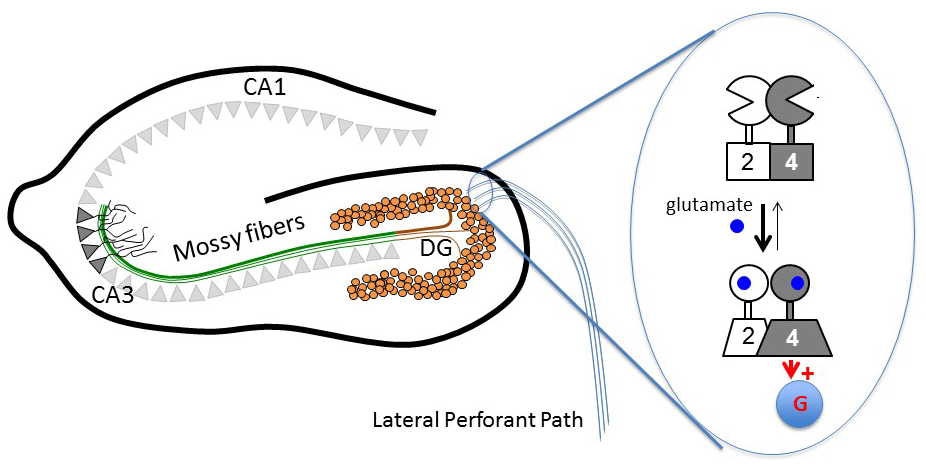
QUAND LES RÉCEPTEURS SE PARLENT, PLUS DE POSSIBILITÉ POUR AGIR !
Deux études apportent des informations importantes sur la capacité des récepteurs métabotropiques du glutamate à former des hétérodimères fonctionnels. Le glutamate est le neurotransmetteur de la plupart des synapses excitatrices dans le cerveau, activant des récepteurs canaux, et il module aussi de nombreuses synapses en activant des récepteurs couplés aux protéines G (RCPG), les récepteurs métabotropiques du glutamate (mGluRs). Huit gènes codant pour ces récepteurs sont présents dans le génome des mammifères.
Après leur découverte au début des années 80 au CCIPE (l’actuel IGF), et leur clonage et caractérisation fonctionnelle dans les années 90, ces 8 gènes étaient considérés comme conduisant à 8 récepteurs homodimériques (constitués de deux fois la même sous-unité). En 2011, nous avons démontré que 16 autres récepteurs pouvaient se former par association de sous-unités différentes dans des cellules transfectées, augmentant les possibilités de moduler des fonctions cérébrales en ciblant ces récepteurs hétérodimériques.
Dans deux articles publiés dans eLife, les auteurs montrent que l’hétérodimère mGlu2-4 (composé d’une sous-unité mGlu2 et d’une sous-unité mGlu4) a des propriétés bien particulières, tant pharmacologiques que fonctionnelles. Dans la première étude, les auteurs montrent que cet hétérodimère peut être identifié dans le cerveau, en particulier au niveau des terminaisons de la voie perforante sur les neurones des grains du gyrus denté, dans l’hippocampe. La seconde étude montre le fonctionnement allostérique complexe de cet hétérodimère dans lequel seule la sous-unité mGlu4 active la protéine G, alors que la sous-unité mGlu2 a une action modulatrice.
Cette étude a été réalisée en étroite collaboration avec notre partenaire chinois (Prof JF Liu, HUST, Wuhan). Plus généralement, sachant que de nombreux RCPG ont été décrits comme assemblés en hétérodimères, ces résultats offrent un bel exemple de contrôle allostérique au sein d’un hétérodimère de RCPG, les cibles principales des médicaments.
Lien Publication Moreno et al.
Lien Publication Liu et al.
WHEN RECEPTORS TALK TO EACH OTHER, MORE POSSIBILITIES TO TREAT !
Two studies bring important information on the capacity of metabotropic glutamate receptors to form heterodimers. Glutamate is the neurotransmitter of most fast excitatory synapses in the brain acting at ligand-gated ionotropic receptors, but it also modulates the activity of many synapses by acting at G protein-coupled receptors (GPCR), called metabotropic receptors (mGluRs). Eight genes encoding mGluRs are found in mammalian genomes. After their first identification in the mid 80's at the CCIPE (now IGF), and their cloning and functional analysis in the early 90's, these 8 genes were considered as generating 8 different homodimeric receptors (composed of twice the same subunit).
In 2011, we demonstrated that 16 additional mGluRs composed of two different subunits could be detected in transfected cells, offering novel possibilities to modulate brain function more precisely. In the present studies, the authors show that mGlu2-4 heterodimers display unique properties leading to specific pharmacological and functional properties. The first study brings evidence for the existence of mGlu2-4 heterodimers (composed of an mGlu2 and an mGlu4 subunits) in the brain, especially in the terminals of the lateral perforant path on the granule cells of the dendate gyrus (DG) in the hippocampus. The second study illustrates the complex allosteric control of one subunit on the other, making only one (mGlu4) capable of coupling to G protein, while the other (mGlu2) has a modulatory effect.
This second study was developed thanks to our well-established collaboration with China (Prof JF Liu, HUST, Wuhan). Finally, since many GPCRs have been shown to form dimers and heterodimers, this latter study brings important information for our understanding of the allosteric interaction between GPCRs, the main targets for actual drugs on the market.
Publication link Moreno et al.
Publication link Liu et al.





